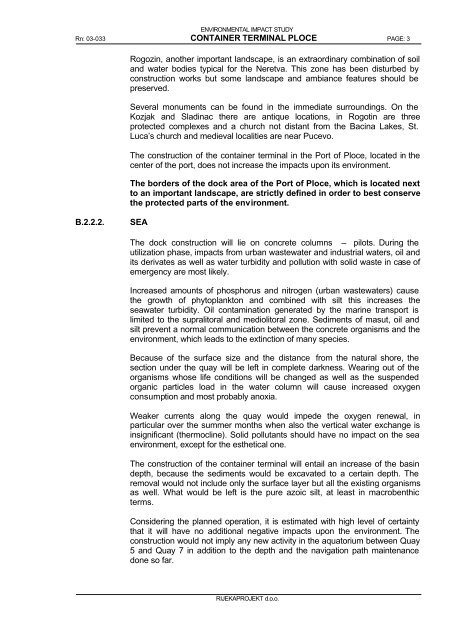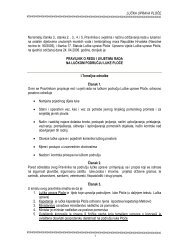HEADING PAGE - port of ploce authority * welcome
HEADING PAGE - port of ploce authority * welcome
HEADING PAGE - port of ploce authority * welcome
You also want an ePaper? Increase the reach of your titles
YUMPU automatically turns print PDFs into web optimized ePapers that Google loves.
ENVIRONMENTAL IMPACT STUDY<br />
Rn: 03-033 CONTAINER TERMINAL PLOCE <strong>PAGE</strong>: 3<br />
B.2.2.2. SEA<br />
Rogozin, another im<strong>port</strong>ant landscape, is an extraordinary combination <strong>of</strong> soil<br />
and water bodies typical for the Neretva. This zone has been disturbed by<br />
construction works but some landscape and ambiance features should be<br />
preserved.<br />
Several monuments can be found in the immediate surroundings. On the<br />
Kozjak and Sladinac there are antique locations, in Rogotin are three<br />
protected complexes and a church not distant from the Bacina Lakes, St.<br />
Luca’s church and medieval localities are near Pucevo.<br />
The construction <strong>of</strong> the container terminal in the Port <strong>of</strong> Ploce, located in the<br />
center <strong>of</strong> the <strong>port</strong>, does not increase the impacts upon its environment.<br />
The borders <strong>of</strong> the dock area <strong>of</strong> the Port <strong>of</strong> Ploce, which is located next<br />
to an im<strong>port</strong>ant landscape, are strictly defined in order to best conserve<br />
the protected parts <strong>of</strong> the environment.<br />
The dock construction will lie on concrete columns – pilots. During the<br />
utilization phase, impacts from urban wastewater and industrial waters, oil and<br />
its derivates as well as water turbidity and pollution with solid waste in case <strong>of</strong><br />
emergency are most likely.<br />
Increased amounts <strong>of</strong> phosphorus and nitrogen (urban wastewaters) cause<br />
the growth <strong>of</strong> phytoplankton and combined with silt this increases the<br />
seawater turbidity. Oil contamination generated by the marine trans<strong>port</strong> is<br />
limited to the supralitoral and mediolitoral zone. Sediments <strong>of</strong> masut, oil and<br />
silt prevent a normal communication between the concrete organisms and the<br />
environment, which leads to the extinction <strong>of</strong> many species.<br />
Because <strong>of</strong> the surface size and the distance from the natural shore, the<br />
section under the quay will be left in complete darkness. Wearing out <strong>of</strong> the<br />
organisms whose life conditions will be changed as well as the suspended<br />
organic particles load in the water column will cause increased oxygen<br />
consumption and most probably anoxia.<br />
Weaker currents along the quay would impede the oxygen renewal, in<br />
particular over the summer months when also the vertical water exchange is<br />
insignificant (thermocline). Solid pollutants should have no impact on the sea<br />
environment, except for the esthetical one.<br />
The construction <strong>of</strong> the container terminal will entail an increase <strong>of</strong> the basin<br />
depth, because the sediments would be excavated to a certain depth. The<br />
removal would not include only the surface layer but all the existing organisms<br />
as well. What would be left is the pure azoic silt, at least in macrobenthic<br />
terms.<br />
Considering the planned operation, it is estimated with high level <strong>of</strong> certainty<br />
that it will have no additional negative impacts upon the environment. The<br />
construction would not imply any new activity in the aquatorium between Quay<br />
5 and Quay 7 in addition to the depth and the navigation path maintenance<br />
done so far.<br />
RIJEKAPROJEKT d.o.o.



